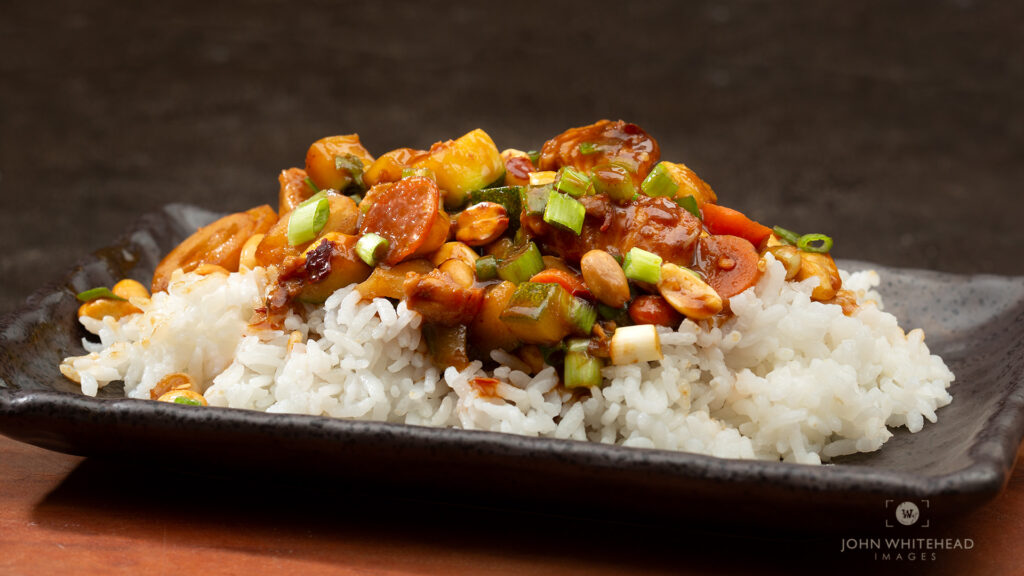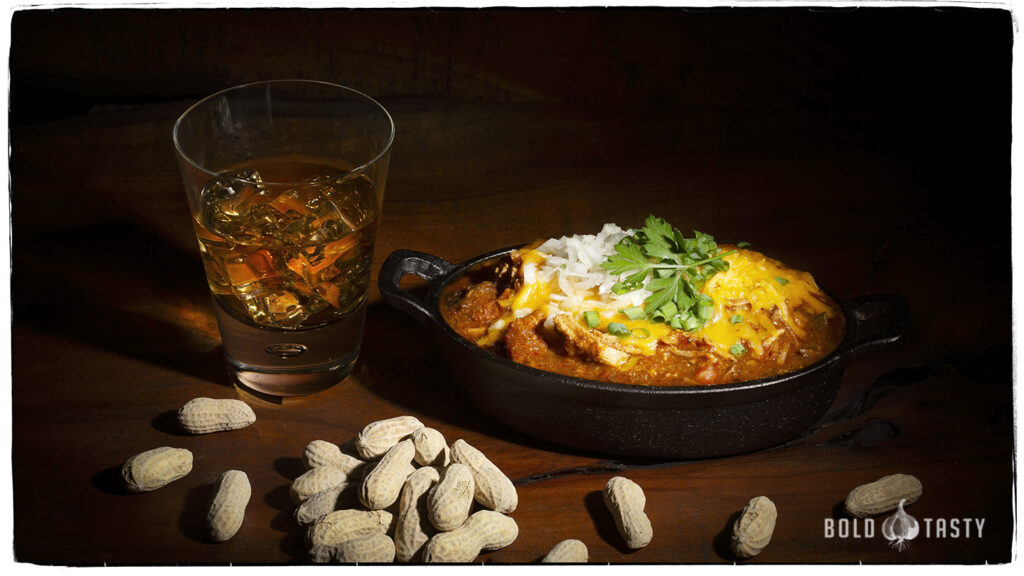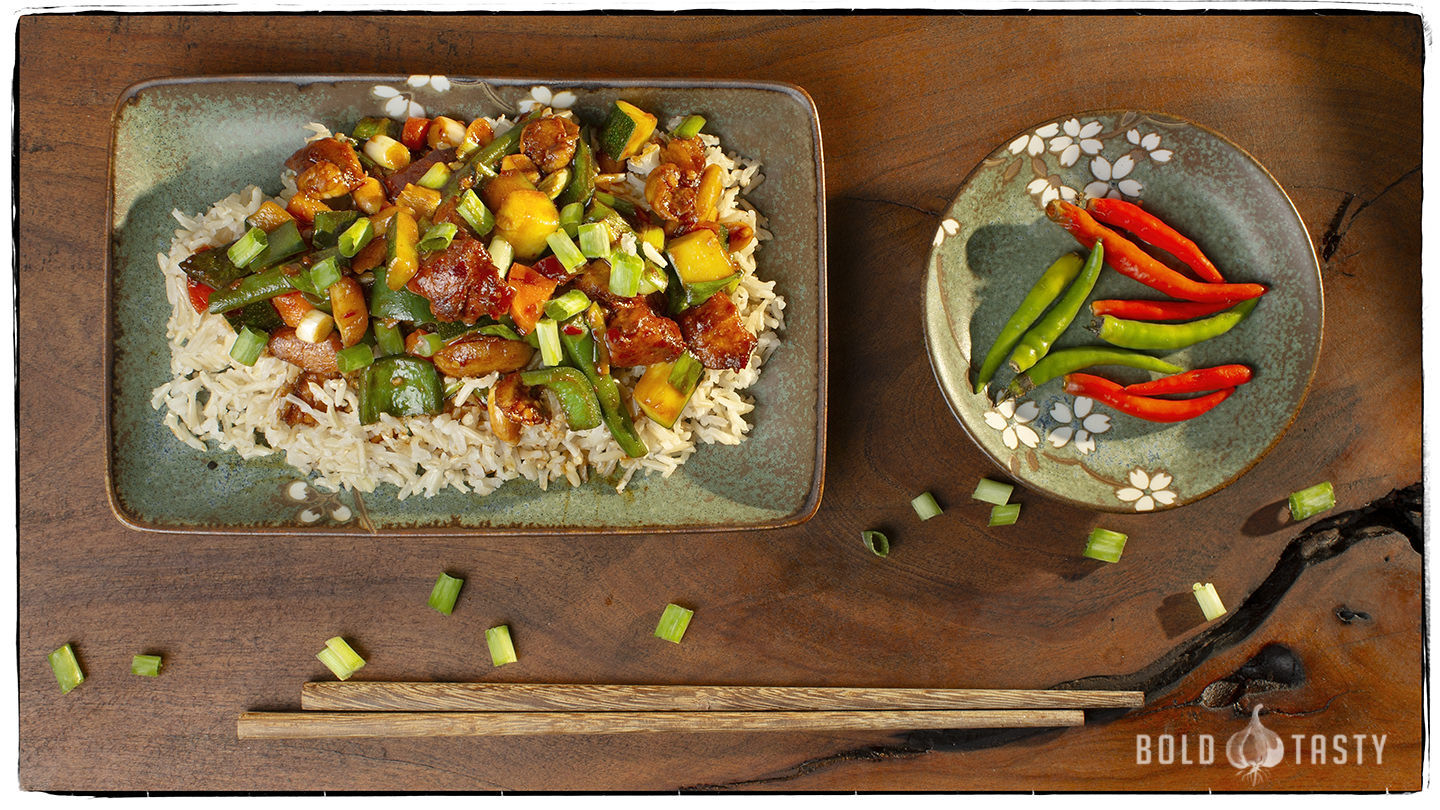
Knock your Socks Off-Healthy Kung Pao Chicken
Healthy Kung Pao Chicken with brown Basmati rice, also known as Gong Bao Jin Ding, is one of my favorite Chinese dishes. While I usually make it with chicken, you can easily substitute shrimp or any other protein of your choice. I first attempted this dish after watching Yan Can Cook on PBS in the ’80s. I tend to enjoy hot and spicy dishes, which might explain why it’s a staple for me.
A friend of mine, whose father was from Burma (now Myanmar), introduced me to spicy food. Ever since, I’ve made one specific adjustment to add heat to most of my Chinese recipes: instead of using hot peppers—since I don’t like biting into them—I use chili crisp and Guilin style chili sauce. The one I buy is from an Asian market and has a label that’s entirely in Chinese. It gives the same level of heat but with a much better flavor, in my opinion.
I understand not everyone has access to Asian markets, so I’ll mention which ingredients in my Kung Pao Chicken recipe are optional. Additionally, I used carrots, water chestnuts, poblano peppers, zucchini, green beans and green onions, but feel free to substitute with vegetables you prefer.
A few alternative ingredients I love are poblano peppers instead or greed or red peppers, and the addition of snow peas. They taste great and have a beautiful color. This dish was made sugar free with Truvia Brown sugar. This recipe is low in sugar, but sodium levels might be to much for some.
What is the History of Kung Pao Chicken?
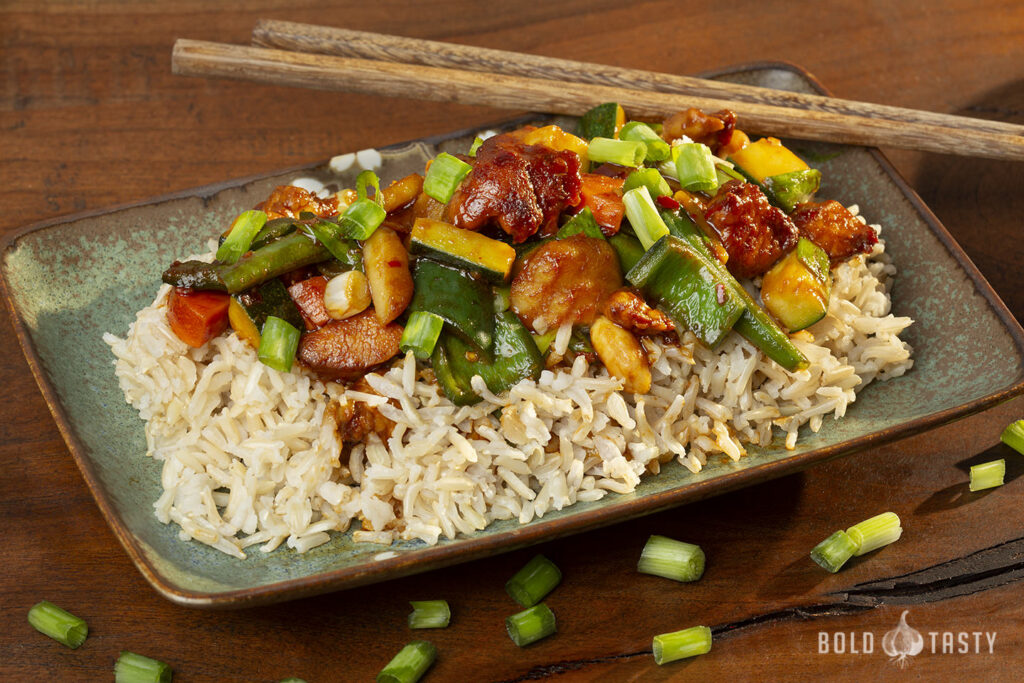
Healthy Kung Pao Chicken, or Gong Bao Ji Ding (宫保鸡丁), is a classic Chinese dish with a rich history, rooted in Sichuan cuisine. The dish is named after a Qing Dynasty official, Ding Baozhen (1820–1886), who held the title of “Gong Bao,” or palace garden. As governor of Sichuan province, Ding developed a fondness for the spicy flavors of the region. According to legend, he created a dish using diced chicken, peanuts, and dried chili peppers, which became a favorite in his household. Over time, the recipe spread and was named in his honor.
Sichuan cuisine, known for its bold and spicy flavors, heavily influenced Kung Pao Chicken. The dish features a signature combination of Sichuan peppercorns, which create a tingling, numbing sensation, and dried chilies for heat. Peanuts or cashews are added for crunch, along with vegetables like bell peppers and green onions. The result is a balance of spicy, sweet, sour, and savory flavors that reflect the complexity of Sichuan cooking.
During the Cultural Revolution in China (1966–1976), many traditional names and dishes were altered to remove associations with historical figures. As a result, Kung Pao Chicken was temporarily renamed “Fast-Fried Chicken Cubes” (Hong Bao Ji Ding). After the political climate stabilized, the dish reclaimed its original name and continues to be enjoyed throughout China and around the world.
Today, variations of Kung Pao Chicken can be found in many countries. While the Sichuan version remains the most authentic, milder adaptations with less heat and more sweetness are common in Westernized Chinese cuisine, making it a globally recognized favorite.
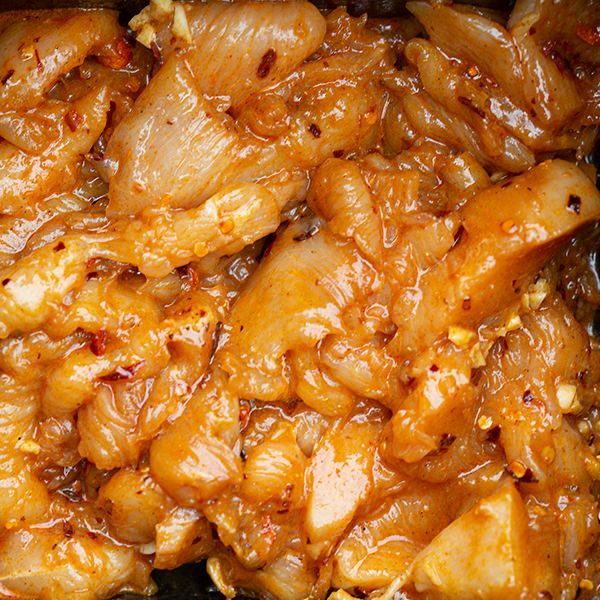
Healthy Kung Pao Chicken Marinade
I believe that a good marinade is essential for a tasty and moist chicken. I typically let mine rest overnight; however, six hours is the minimum required. While some recipes suggest resting for just 30 minutes, in my experience, that’s not enough time for it to work its magic. Fortunately, the preparation is quick—it only takes me about five minutes to get it ready the day before.
My other suggestion is make sure you use dark soy sauce, not regular. Some brands my say premium or dark premium soy sauce.
Wash Your Rice or Brown Rice
Yes, you need to wash rice before you cook it. Washing rice will remove starch, and reduce the level of arsenic. I usually soak and wash my rice for 20 minutes. You will need to change the water 7-10 times, or until the water is clear. If you use basmati rice, definitely make sure you soak your rice for 20-25 minutes. Basmati is a long grain rice which if different that most Chinese medium and short grain rice. Basmati is a light and fluffy rice vs. a stickier rice. I usually use Nishiki Premium Medium Grade Rice for Chinese Food. I use Zebra Brand Basmati Rice for Thai and Indian dishes. Short grain rice is very stick and is usually used for sushi or sticky rice. Always refer to the directions. I am using Kohinoor brown basmati rice .

Ingredient of the Day-Soy Sauces
The key differences between light, regular (normal), and dark soy sauce lie in their color, flavor, and intended use:
1. Light Soy Sauce
- Color: Light soy sauce has a thinner, lighter appearance with a reddish-brown hue.
- Flavor: It is saltier, has a more delicate, and subtle flavor compared to dark soy sauce. Soy sauce provides a sharp umami taste and is often used to season dishes without adding too much color.
- Uses: Light soy sauce is typically used in marinades, stir-fries, and as a dipping sauce. It’s the go-to soy sauce for flavoring without darkening the dish.
2. Normal (Regular) Soy Sauce
- Color: Regular soy sauce has a medium-brown color, it is darker than light soy sauce but lighter than dark soy sauce.
- Flavor: It offers a balance of saltiness and sweetness, making it versatile for various dishes.
- Uses: This soy sauce is commonly used for seasoning and adding color. It’s suitable for most cooking purposes, including stir-fries, soups, and marinades.
3. Dark Soy Sauce
- Color: Dark soy sauce is much thicker and darker in color, almost black, due to a longer aging process and the addition of molasses or caramel.
- Flavor: It has a richer, sweeter flavor with less salt than light soy sauce. The extended aging gives it a more complex taste.
- Uses: Dark soy sauce is used primarily for adding color and depth to dishes, such as braised meats and stews. It’s less about seasoning and more about enhancing the appearance and providing a subtle sweetness.
In recipes, these soy sauces are often used together to achieve a balance of flavor and color.
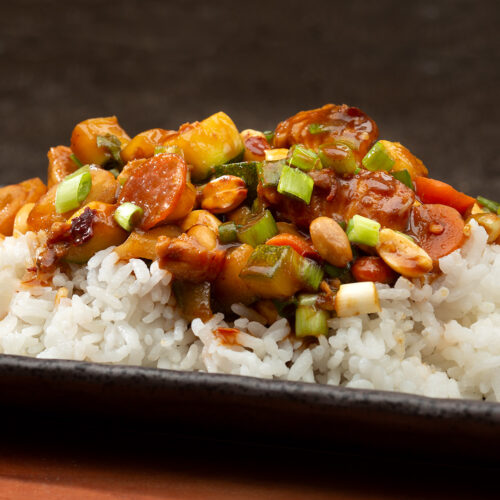
Kung Pao Chicken
Equipment
- 1 small bowl for marinade
- small bowl for sauce
- 1 pot or rice steamer for rice
- 1 wok or saute pan for main dish
Ingredients
Chicken Marinade
- 1 large chicken breast or cubben chicken 430 grams
- 1 tsp dark soy use dark not regular
- 1 tsp sesame oil that nutty flavor
- 1 tsp mirin or rice wine vinegar
- 1 tsp chili crisp
- 1 ½ tsp corn startch
Kung Pao Sauce
- 1 tbsp black vinegar
- 1 tsp shaoxing wine
- 1 tsp sesame oil
- 2 tbsp raw sugar or light brown sugar/for sugar free use Truvia Brown sugar
- 2 tbsp hoisin sauce
- 1 tsp dark soy sauce
- 2 tsp Guilin Style Chili Sauce.
- 1 clove garlic chopped
- ¼ tsp white pepper
- 1½ tsp corn starch
- salt to taste
Kung Pao Ingredients
- ½ cup carrots or 73 grams
- ¾ cup water chestnuts 15 oz or 160 grams
- ½ cup chopped green peppers 75 grams I used poblano peppers
- 1 cup cubbed zucchini/green squash 170 grams
- ½-⅓ cup dry unsalted peanuts
- ½ cup green onions/scallions 28 grams
Rice
- 1-2 cups medium grain rice or Basmati brown rice for healthier option
- water as per directions
Instructions
Chicken Marinade
- add chicken and all marinade ingredients to bowl and mix1 large chicken breast or cubben chicken 430 grams, 1 tsp dark soy, 1 tsp sesame oil, 1 tsp mirin or rice wine vinegar, 1 tsp chili crisp, 1 ½ tsp corn startch
- refrigerate for 6 hours to overnight
Rice
- wash rice with cold water1-2 cups medium grain rice or Basmati brown rice for healthier option
- cook as per directions
Kung Pao Chicken
- heat wok
- toast peanuts on low heat for about 30 seconds while tossing½-⅓ cup dry unsalted peanuts
- add about 1-2 tbsp of oil
- stir fry chicken until 75 percent done
- remove chicken from pan
- add vegetables except green onions and stir fry for 2-3 minutes depending wok heat You can add a tbsp of water to help steam½ cup carrots or 73 grams, ¾ cup water chestnuts 15 oz or 160 grams, ½ cup chopped green peppers 75 grams, 1 cup cubbed zucchini/green squash 170 grams
- add chicken back into pan and mix
- add kung pao sauce. It must heat to a simmer to thicken. Add more cornstarch slurry if you need to thicken it more1 tbsp black vinegar, 1 tsp shaoxing wine, 1 tsp sesame oil, 2 tbsp raw sugar or light brown sugar/for sugar free use Truvia Brown sugar, 2 tbsp hoisin sauce, 1 tsp dark soy sauce, 2 tsp Guilin Style Chili Sauce., 1 clove garlic chopped, ¼ tsp white pepper, 1½ tsp corn starch, salt to taste
- once thick and done add green onions and peanuts½ cup green onions/scallions 28 grams, ½-⅓ cup dry unsalted peanuts
- remove from heat and serve Enjoy

